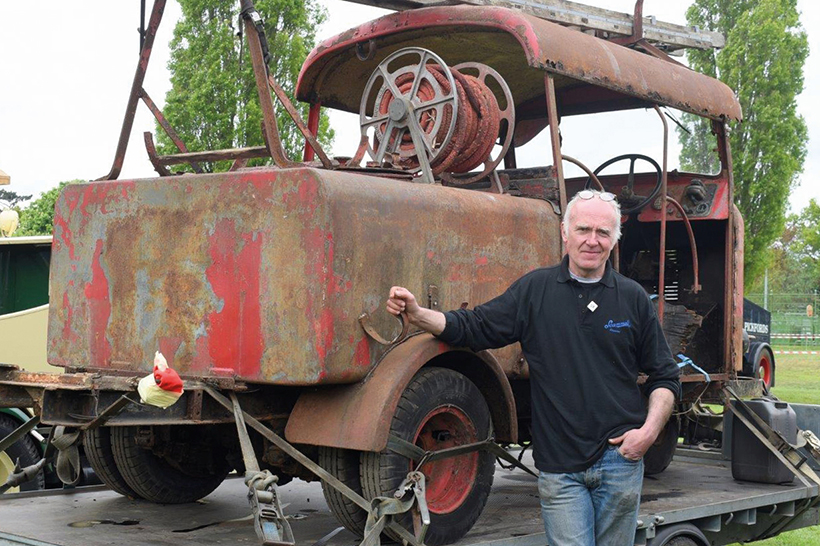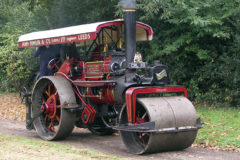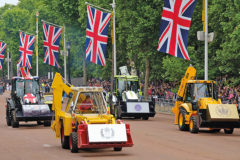100th anniversary of Scammell Lorries
Posted by Chris Graham on 12th August 2022
Zack Stiling reports from the great event which celebrated the momentous, 100th anniversary of Scammell Lorries Ltd.

Scammell Lorries: Two Pioneers were present, both in post-war RAE Farnborough colours.
Exactly 100 years to the day after Scammell Lorries Ltd opened its Tolpits Lane factory in Watford, on May 1st, 1922, one of the largest Scammell-only gatherings took place just down the road to celebrate the milestone anniversary.
Thanks to the generosity and co-operation of Watford Borough Council, the Scammell Register commandeered the King George V Playing Fields for a rally which saw 27 Scammells congregate over the bank holiday weekend, plus a solitary Austin A40 van in the livery of Parker Bent, the haulage contractor and Scammell service agent.

John Butler’s splendid 1928 model has a rich history and wears its 1960s restoration well.
Scammell’s origins actually go back much further than 1922. It was in the late 19th century that George Scammell founded G Scammell & Nephew on Fashion Street in Spitalfields as a wheelwright and body-building firm. The business first expanded to include the sale and maintenance of Foden tractors, and one customer, haulier Edward Rudd, had imported a Knox from America and it so pleased him that he suggested Scammell produce something similar. That and the rapid development of mechanical transport during the Great War convinced Scammell that there was money to be made in powered lorries.
George’s great-nephew, Lt Col Alfred Scammell, applied practical knowledge acquired in the war to make a prototype articulated six-wheeler with a 7½-ton payload, along the lines suggested by Rudd, which was presented at the 1920 Commercial Motor Show. Suddenly, Scammell found itself having to fulfil orders for 150 six-wheelers, but the Spitalfields site was nowhere near big enough. Scammell relocated to Watford where it remained for the rest of its life.

This handsomely-restored 1930 tractor unit completed the chain-drive line-up.
Scammell prospered in its new occupation as a lorry maker, but it would experience some difficulties in the 1950s which resulted in it becoming a part of Leyland Motors in 1955. Leyland, of course, was running into troubles of its own by the 1980s, and in 1987 its lorry division merged with DAF. Sadly, DAF elected to do away with the Tolpits Lane factory in July 1988 and, with that, Scammell’s days were numbered. Its name lived on for just a few more years while the S26 and the British Army’s DROPS lorry continued to be built at the Leyland works.
The Centenary Celebration succeeded in telling the Scammell story from beginning to end, with at least one lorry from every decade of production, including three early chain-drive examples. This line-up included John Butler’s splendid 1928 12-tonner, which has been on the preservation scene for over half its life and is now delightfully ‘oily rag.’

► This 1950 Scarab, a patinated survivor from London’s East End docks, led the road run on its way.
Works No. 1240 was originally supplied as a machinery carrier to EW Rudd (he of Knox fame, and by now a director of Scammell) of East London, but it is reputed to have ended up coupled to a van body on long-term loan to Wilmington Stores. Later, it ended up with Archie Redburn of the Coronation Garage on Falcon Road, Ponders End. Redburn is known as the last man dealing in petrol-engine and chain-drive Scammell spares and, although 1240 was quite aged, its survival was down to its reliable starting on cold mornings when everything else failed.
John Butler bought it for restoration in 1962, achieved with the help of Archie’s son Tom, and for many years it continued earning its keep as a working vehicle, being used for the recovery of other heavy restoration projects. Besides its rich history, its other claim to fame is that it has for some time been the oldest roadworthy Scammell, although we understand that the recent restoration of an earlier model means that may no longer be the case.

Roger Annis with the eight-cylinder Scammell his father built.
While our interest is primarily focussed on these earlier commercials, special mention must be given to Crouch Recovery’s 1990 S26, one of the last vehicles to bear the Scammell name and the only post-1970s vehicle in attendance. Late Scammells do not seem to have acquired the same popularity as earlier ones, so it was good to see such a well-preserved example.
One of the more unusual lorries on the field was the ‘Scammell-Annis’, the sole survivor of three bespoke Scammells built by heavy-haulage operator Frank Annis of Pump Lane, Hayes, Middlesex, circa 1965. It’s now owned by his son Roger, who explains, “My father approached Scammell about building some lorries with straight-eight Gardner engines. Scammell said it couldn’t do it because it would take too much chassis alteration. My father wouldn’t settle for a six-cylinder so he took the oldest 45-tonners from his fleet and adapted them.”

David Walker contemplates what he’s got himself into with his challenging Mechanical Horse project.
Lined up among some Highwaymans, the Annis Scammell is visibly bigger. The engine sticks out five inches further at the front and pokes into the cabin a further five inches. It has a military gearbox and is now rated as a 65-tonner. Originally registered YUV 211, the licensing authorities decreed it had to be re-registered because such extensive work had been completed.
When Frank Annis had finished with his creation, he sold it to JH Moore, another Pump Lane haulage contractor. It later joined Gerry Cottle’s Circus and ended up with an elderly enthusiast who used it for pulling a traction engine. When he had to give up driving, Roger seized the opportunity to acquire it and, with the help of Tony Wise, returned it to its former glory.

1966 Scammell Highwayman originally worked at Pickfords’ Glasgow depot.
Two real highlights were the restoration projects brought along by Secretary of the Scammell Register, David Walker. One was probably the oldest vehicle on site, believed to be a 1927 lorry which had originally served as a ballast tractor at Pickfords’ London Bridge depot. However, it passed through the hands of various showmen so its history is far from complete. David bought it from John Butler, who had made a start on its restoration, getting the engine and rolling chassis together, but David brought it up to its present condition with the bodywork taking shape. The Centenary display marked its rally début.
Even more interesting is his 1938 Mechanical Horse fire engine. It was part of a run of 13 built for the AFS, though this one is believed to have been retained by the Scammell factory but is not thought to have ever fought a fire. At some point, probably in the late 1960s, it was retired and placed in a Scammell director’s garden as a plaything for his children. In the early 1980s, it passed to a collector who left it in the garden of his Kew townhouse before moving it to open-air storage near the Kent coast. When circumstances forced its sale and David got wind of it, he knew he had to save it.

1962 Highwayman regularly attends events in the south.
Fortunately, the engine will run, but a new chassis and new woodwork will be in order, and David rightly plans to preserve as much of its original finish as possible. Remarkably, an ex-Scammell employee who remembered the fire engine visited the Centenary and was able to add a few details to its history. Apparently, Scammell used to take it along to the Hertfordshire County Show where it would fill up the livestock’s water troughs.
A similar recent discovery, although not present at the rally, was the sorry remains of what is believed to be one of two Scammell fire tenders supplied in 1935 to the Borough of Watford fire service. Embarking on its restoration would seem like a good way of celebrating Scammell’s 100th anniversary, although its state of dereliction means it would be a big commitment. Enquire of the Scammell Register for more information.

1938 Scammell ballast tractor had a short drive into Watford from the Chilterns.
Also making its show début was Frank Lord’s 1959 Constructor, a monster of a vehicle with more than a hint of the film Duel about it. Frank says, “It was one of four ordered by the Hungarian government for oil exploration. It went around Hungary drilling for oil and they found it in 1965. It was a great success – they’re still pumping oil from those holes.”
The government later gave it to a college which ran a course in oil exploration, and Frank bought it after spotting it on eBay. He understands that the man who maintained it for the college was given it as a retirement present or allowed to buy it at a very low price. It appears to be bespoke on two counts, one being that the front suspension consists of two heavy-duty coil-overs in place of the usual transverse leaf spring, and the second being that the cab is visibly offset, so the driver gets an unhindered view of the terrain ahead. The original blue paint is visible in places, and Frank isn’t certain how it came to be yellow.

Adam Johnson purchased his 1938 Scammell MU tanker from the Roger Austin sale last year. It was originally used for 34 years transporting acids.
Never having owned a Scammell before, Frank was brave to choose something as large as the Constructor, but he couldn’t be happier. “I’ve had great fun. When I was driving it back from Hungary I had about 1,000 followers on Facebook. For an old chap that was quite fun.”
The rally ended with a 25-mile road run along the old factory test route. From the playing fields, the Scammells passed the site of the old works, now a modern housing development, and returned from the A40 via the trailer factory site at Moor Park. I was fortunate enough to be given a seat in Nick Steggel’s marvellous 1975 Crusader, a deceptively quick and comfortable vehicle in spite of its size and rugged nature.

The 1930 Scammell chain-drive is still going strong.
Apart from the drizzly bank holiday weather, there probably couldn’t have been a better way to mark this important anniversary. Thanks are due to Watford Borough Council for the venue and event sponsor CRS Consultants Ltd, without whom it couldn’t have happened, and the Tiffen Recovery fleet which provided transport for the Scammell Register trailer and David Walker’s part-restored lorry. The Scammell Register hasn’t been in the habit of hosting annual rallies, but Parry Davis says “We probably will after the success of this one.” We’ll look forward to seeing what happens.

This ballast tractor from 1952 sped along nicely.

Ex-Army 1955 Scammell Constructor made a for a fearsome sight on the road.
This story comes from the latest issue of Old Glory, and you can get a money-saving subscription simply by clicking HERE





